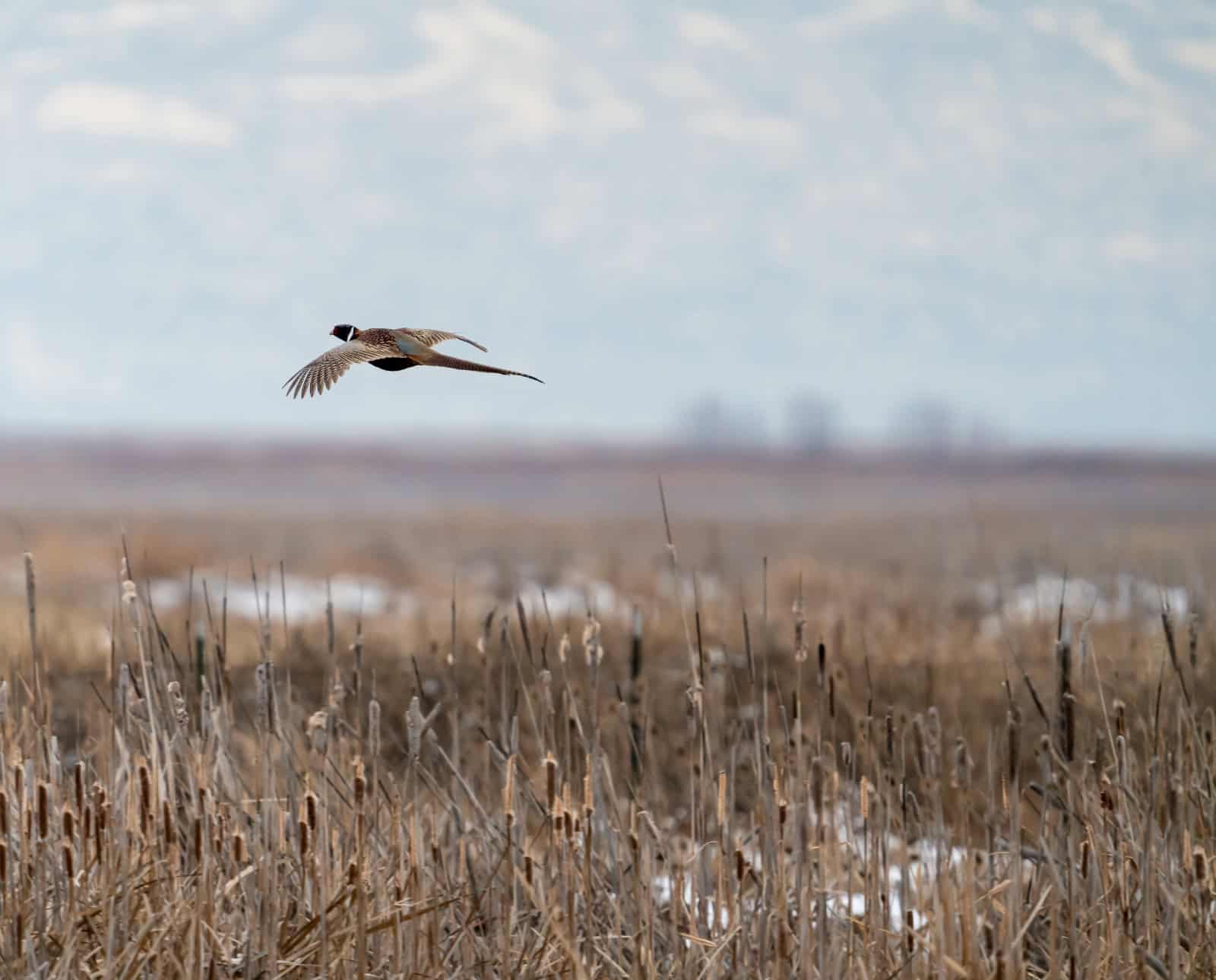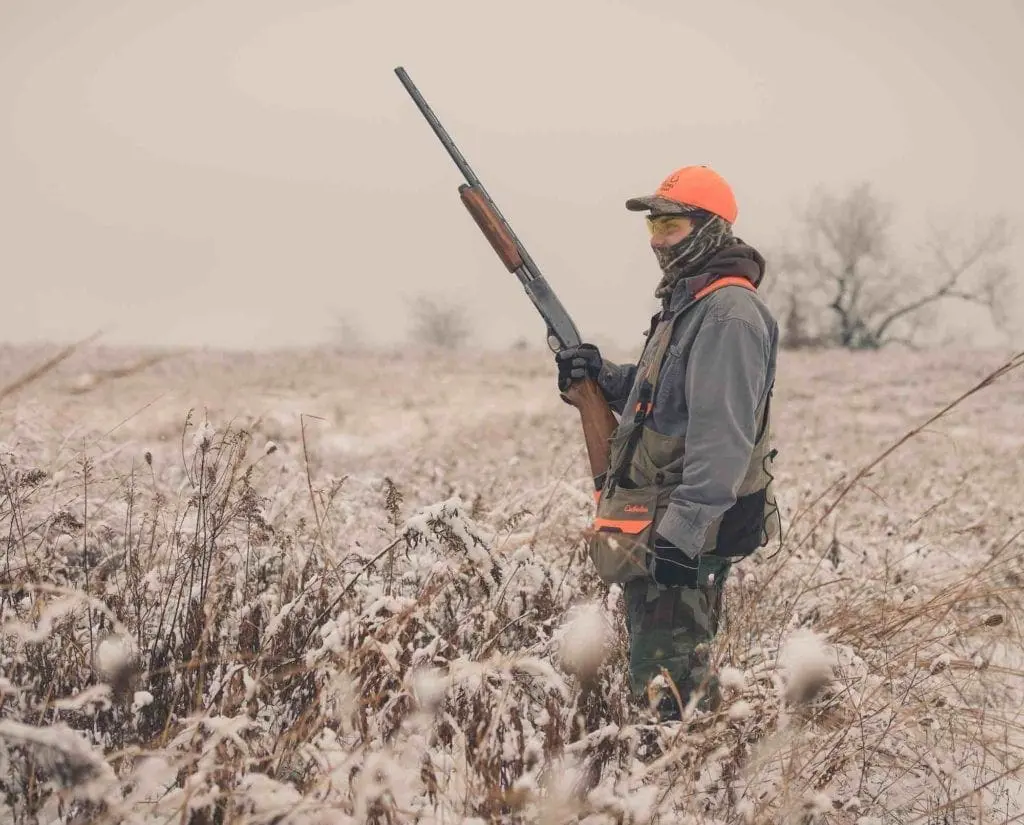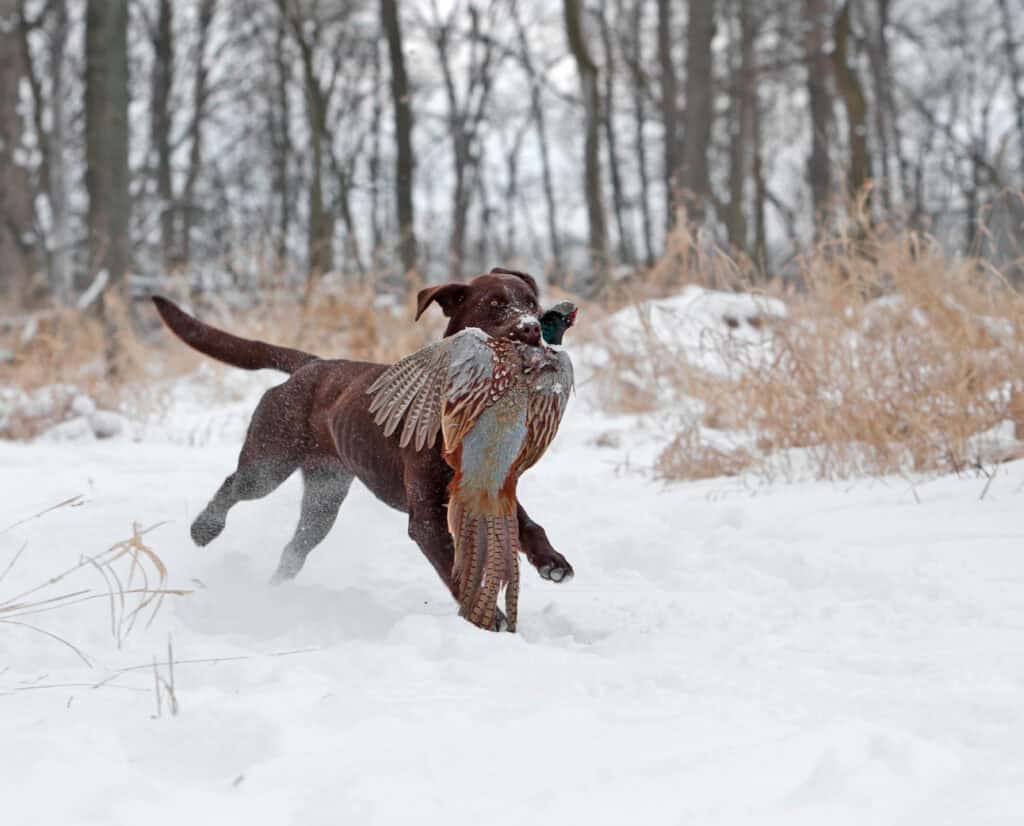Home » Pheasant Hunting » Late Season Pheasant Hunting Tips
Late Season Pheasant Hunting Tips

Frank Loncarich has been a wildlife biologist for over 20…
As pheasant hunting moves later into the season, hunting ringnecks requires a little extra effort to achieve success.
Late-season ringneck hunting isn’t as glorious as opening weekend. Gone are the early season’s young, short-tailed roosters that make up most hunters’ game bags. Long marches across tall grasses or freshly cut crop fields no longer result in dozens of flushes and easy shots for walkers and blockers alike. Rarely do birds hold for solid points, allowing that classic upland experience to unfold for solo hunters.
Listen to more articles on Apple | Google | Spotify | Audible
Instead, birds have been pressured hard, and many of the naive young-of-the-year birds have been harvested. Birds abandoned short cover and crop fields due to winter weather conditions and holed up in thick grass, cattail sloughs, and woody windbreaks for protection. Additionally, due to heavy hunting pressure, roosters are prone to run from approaching hunters or flush too far away for an ethical shot.
This all sounds discouraging, right? Even so, my favorite time to hunt pheasants, besides the first two opening weeks, is the late season. While it’s not easy, pheasant hunting late in the year can be wildly successful.
Let’s look at some tips and tricks for harvesting more roosters when the season’s end nears.
Late Season Can Be So Good
Why would the late season be one of my favorite times to hunt pheasants? It’s all about the dynamics of pheasant behavior that occur during this time.
As the season progresses and cover is knocked down, birds tend to group up in ever-decreasing pheasant habitat. As a result, birds become more predictable in where they will be found. One can exclude a bunch of unproductive habitat, focusing efforts where success rates are higher. When you find one of these spots and slip in undetected, the resulting explosion of birds and fast action is unlike anything experienced in the early season. String a couple of spots like this together, and you can have one heck of a successful hunt.

Where to Hunt Pheasants In The Late Season
As I mentioned, heavy cover is the key to finding pheasants in the late season. Snow, wind, and ice have knocked down a lot of grassy cover by late early winter. Birds often abandon the short cover used heavily in the early season. Instead, birds look for the thickest cover they can find, but this varies according to where in the country the birds live.
In Kansas and Nebraska, the best cover is most likely tall, thick, native warm-season grass fields enrolled in the Conservation Reserve Program (CRP). In the Dakotas and upper Midwest, CRP fields will still hold birds late in the season. However, are not as thick or tall as they are further south, so they lose some of their wintertime appeal. Birds in northern states often gravitate to thick cattail sloughs or waterways, especially when snow covers otherwise suitable grassy or weedy habitat. Also, look for birds using woody windbreaks. These features provide protection from snow and wind and allow for easier access to food on their downwind sides.
While roosters are looking for places to protect them from predators and harsh weather, they must also eat. The top food choice for pheasants in the winter is waste grain from agricultural operations. Pheasants are rarely found in cover much more than a quarter or half a mile away from a grain field.
Proximity to grain fields is important in determining where to hunt late-season pheasants. A thick, grassy field surrounded by miles of pasture might hold a sharp-tailed grouse or two. However, I certainly wouldn’t expect to find any late-season pheasants there. Instead, key in on thick cover within a short walk or flight of a harvested grain field. Unfortunately, it’s not quite that simple.
By late season, hunting pressure is a huge factor in determining whether a piece of cover is worth hunting. Even the best cattail slough surrounded by acres of harvested corn will hold few birds in January if it’s on public land within a short walk from the road. You can bet these places get hunted often, and birds quickly learn to avoid them.
Get as far away from the road or easily accessible habitat as possible. This is where pre-season scouting, especially remotely with an aerial photography application, comes in handy.
The various computer applications that show updated aerial photography and landowner information are game changers. They help hunters find out-of-the-way places, places where pressure is likely lighter than in areas near roads. Grass fields, cattail sloughs, windbreaks, and crop fields can be readily identified on these applications with practice.
For late-season pheasants, as a starting point, look for thick habitat near food sources at least a half mile from a parking lot or road. Ideal spots are where access to good habitat requires a hike across acres of poor cover to reach it. This situation will discourage many hunters from hitting these spots because there is no chance of getting into birds during the walk to the spot.
The bottom line for late-season pheasant hunting is to first identify thick cover near food sources. Then, scour the area for the hardest to access or most overlooked spots.

How to Hunt Late-Season Pheasants
Hunting pheasants in the late season can be an exercise in frustration. Birds can flush wildly, roosters may never stop running, and good habitat may be devoid of birds due to hunting pressure. However, when done right, it can be fantastic.
Be as stealthy as possible when approaching a hunting spot. Do not slam truck doors, loudly drop tailgates, or talk above a whisper. Always approach the cover with the wind in your face, if possible. This helps your dog with smelling birds but also keeps the birds from hearing your approach. Avoid yelling or whistling at your dog as you approach the cover, too; a well-mannered dog is a real advantage.
When in the habitat, look for the “cover within the cover.” Each cattail slough or grass field has spots of thicker cover within the area as a whole. For example, low spots in CRP fields will often have thicker, taller grass because of higher moisture availability in low areas. These low spots are usually out of the wind compared to the surrounding higher ground. The combination of thicker vegetation and wind protection typically means birds will hole up in these areas in greater numbers than the surrounding habitat. Look for these spots as you move through and approach them carefully. Even when moving quietly, birds will often flush wild. However, your chance of flushing birds close enough for a shot increases dramatically with a quiet approach.
I don’t like to hunt late in the season with more than one or two other people. The more people, the greater the chance birds will detect you and flush wild. Late season is a great time for you and your dog to slowly slip through heavy cover while watching your dog intently. I’ve had excellent luck doing just that, especially when hitting smaller coverts likely to hold just a few birds.
If you do hunt with multiple people, send someone looping well around the cover to block the likely exit routes. Some birds will inevitably run or flush ahead, and this person stands a good chance of getting a shot. This works especially well in shelterbelt situations or where a thick cattail slough or grass patch ends in a piece of short cover. As always, make sure everyone at your party is wearing orange, knows where everyone is, and only takes safe, 45-degree angle shots.
Also, key into harsh weather situations as long as it is safe to go out. High winds and deep snow will cause birds to pile into the best available cover, and they are much more likely to hold tight in these conditions.
Pheasant seasons across the country are long, and having the tools and knowledge to hunt them beyond the opening few weeks is key to extending your season. Plus, hunting can be just as good as early in the season. Remember, find thick cover near food sources well away from easily accessible spots. Move quietly and into the wind, taking advantage of depressions and low spots in the cover to get the drop on unsuspecting birds. The best advice is to get out in the field when the weather is bad, and most people are inside, next to the fire, watching football. You might just have the best hunt of your season.
Frank Loncarich has been a wildlife biologist for over 20 years, specializing in bobwhite and grassland management. He is also a Habitat Consultant for Land and Legacy.




My sister and I would like to go hunting this season, which is why we’re thinking of enrolling in a firearm training class. Thank you for sharing here the importance of investing in quality gears. We’ll also keep in mind to hunt in low-lying areas.